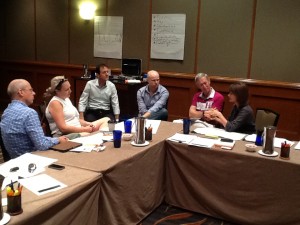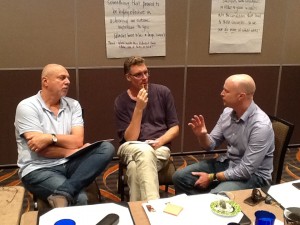Last weekend we ran a leadership retreat for our Heads of Department. The retreat focused on how we learn in teams, how we lead team learning, and how we might document, reflect on, and share our team learning. It was largely a participant-driven event, commencing with a discussion of Amy Edmondson’s book Teaming: How organizations learn, innovate, and compete in the knowledge economy.
Key themes early on in the discussion were grassroots learning, questioning, collegiality, and collaboration. A couple of hilarious role-plays ensued with the Head of Christian Studies acting like an owl (something to do with scaring crows away) and the Headmaster doing a pretty poor job of attempting to revive the Head of Geography after a cardiac arrest. Effective teaming was seen to include: flexibility, collaboration, shared goals, honesty, conflict, and most importantly, plain speaking, feedback, and help – in a psychologically safe environment.
Then, following dinner on Friday evening, Simon Brooks (Head of Teaching and Learning at Masada College) joined us to facilitate a Descriptive Consultancy protocol. This year we have abandoned the concept of staff PD days and instead spread the time into 70 minute subject-specific team learning time on alternate Monday mornings (with the students arriving late, in time for period 2). One of our Heads of Department presented a dilemma about the difficulty keeping tabs on everyone as they undertake an array of disparate tasks in this team learning time. Simon facilitated the discussion brilliantly and my Headmaster later commented, “I felt like we were in the presence of a Master.”
Saturday morning commenced with a period of reflection and prayer, before the Headmaster outlined his thinking on the virtues of leadership. “The effectiveness of the leader will be tied to the respect that the leader can command and that will be generated by the character of the leader and the virtues she can display consistently and truthfully.” He spoke about how the work of teachers and leaders in a school is a moral task, the importance of developing practices shared by the group through meetings and interpersonal actions, and not just having good ideas but enacting those ideas.
Then there was an opportunity for each Head of Department to share their dilemmas related to their leadership of the team learning time. There was discussion about: resolving tensions, building disparate individuals into a team, making time to play together, the frequency and effectiveness of meetings, best practice in teaching, building on expertise, monitoring the learning, developing and promoting cultures of thinking, sharing weaknesses/struggles, letting voices be heard, flattening structures, reflecting, and big picture thinking.
Following this an Open Space-style unconference was held with participants proposing their own topics of interest and then hosting their own discussions. Five conversations ensued:
Cultures of thinking – How do we move the Cultures of Thinking approach from department to whole-school? Various approaches were discussed including: show and tell (read, trial, share), suggest don’t mandate, ask for feedback, use noticeboards (in class, around the school, and electronic). There was also discussion of specific routines, like See…Think…Wonder… and Compass Points.
The evolving role of the Head of Department – A mindmap was produced that covered this topic. How do HoDs find time for all these things? What is suffering as a result of the role/workload increasing? How does the Executive help or hinder our role? To what extent are all stakeholders aware of each other’s demands and how time-consuming these demands are? New roles are appearing and roles are expanding. Expectations in fulfilling the role are both personal and school-based. Who can support us? How?
Documentation and sharing – The benefits of documentation are: deeper thinking, starting conversations, sharing between departments and building on each other’s efforts, sharing/reflecting on the process/progression/learning and where that might lead to next, valuing more than the finished product, encouraging team collaboration to inform and improve. ‘Share-worthy’ material does not have to be perfect and packaged, it can be a work-in-progress rather than ready to use. Reflection and improvement, and growth mindset are needed to keep it moving forward, to not just avoid failure, but avoid plateauing or sticking to the status quo. It should be seen as a comment/feedback space, not show and tell. We need to learn from mistakes and share what didn’t work so others can learn from it, and celebrate our mistakes. We should replace displays regularly, like in primary schools, so it becomes a talking point.
- Could the exhibition and design crew service group be responsible for documenting and sharing some student and teacher work?
- Can we make use of the Reggio experts in our school or visit Reggio pre-schools to see how they do it?
- Could we introduce the concept of a rotating citizen journalist, where each week a different team member documents a snapshot of a team’s learning to share?
- Should each department have a dedicated documentation space that both staff and students can see?
Getting the best out of people – Relationships are important. Focus on the positives. Specific praise/ positive feedback, flexibility, celebrate small steps, respect/interest outside the classroom, depersonalise risk by using conditional statements.
Cross-departmental collaboration – Having teacher-librarians and academic support staff involved in the planning of coursework, resources, skills, helping decode questions, cross-faculty collaboration provides equitable skills/resource assistance to all students and everyone benefits, awareness of the importance of information skills/academic support is available throughout the learning spectrum, team-teaching across departments where the opportunity presents, look at each department’s schedules for the opportunities.
The afternoon was then rounded out with the Success Analysis protocol, which shares successes with colleagues in order to gain insight into the conditions that lead to those successes, so we can do more of what works. Some of the key conditions that lead to success were identified as:
- Planning
- Explicit communication
- Differentiating and awareness of differences
- Listening, giving people a voice, and setting aside time (eg. goal-setting conversations)
- Persistence against resistance
To conclude the retreat, participants were asked to write a reflection based on the retreat goals. The following summarises the key themes in the responses:
How do we learn in teams?
- Valuing everyone’s input
- Respecting conflicting points of view
- Ensuring ‘psychological safety’
- Common/shared goals, agreed to by the team
- Being willing to take risks, experiment, and fail
- Listening/documenting actively
- Being honest
- Communicating openly
- Trusting others
- Collaborating
- Having time to reflect on what happened
How do we lead team learning?
- Giving everyone a voice and a right to be heard
- Giving up your leadership to others, to allow them to grow
- Modelling good practice
- Learning from mistakes and allowing the team to fail forward
- Sharing agreed goals
- Using protocols as a means of moving forward in a structured way and keeping conversations on track
- Showing interest in others
- Using the expertise and experience of others
- Developing a culture of trust
How might we document, reflect on and share team learning?
- Valuing protocols for reflecting on team learning
- Finding a physical space to document learning for staff and students
- Celebrating the process rather than just the final product
I found two of the written reflections particularly striking:
“The revelation for me at this conference has been the effectiveness of ‘the protocol’. The structure it brings to discussion and the fact that it is a very inclusive way of dealing with a problem or discussing a strategy. I think this is going to be a very valuable tool for our department when trying to ‘move forward’ with certain issues. I look forward to getting more information on these different protocols.” (Matt)
“I think the focus on learning in our teams is under threat or at least the desire to make our teams a place of learning is being resisted. I heard stories of resource development and new ideas being implemented but I wonder if we can accurately describe this as learning. Is developing a new assessment for Year 9 really learning? Perhaps co-creation does involve learning but this seems to be a question that is still being worked out.” (Doug)
I’m wondering about Doug’s point above – what is the difference between ‘learning’ and ‘work’ for teachers? Does the Descriptive Consultancy protocol provide a help-seeking model for us to work towards, where educators present problems or dilemmas and receive feedback from their peers within a safe structure? Would cross-curricular teams operate more effectively than subject-specific teams? How can we bring students into the conversations we are having about their learning?
Words like ‘flourish’, ‘professional’, and ‘team’ dominated the conversations during the retreat and I left enthused by the flourishing, professional team I am learning with.




When discussing what is helpful in teaching and learning at a university setting, a social work colleague of mine commented that we are meant to provide an “ambassadorial role” to our students. It seems like this word might prove suitable for learning in teams. Great read and thank you for sharing it. Take care, Janet